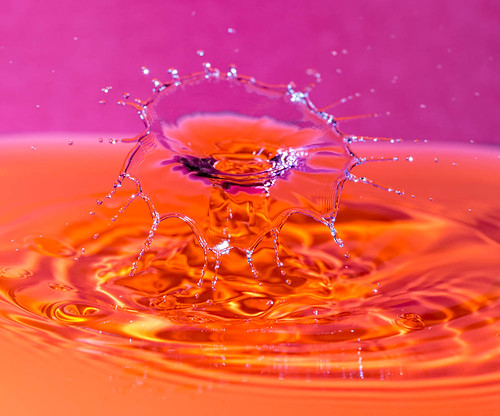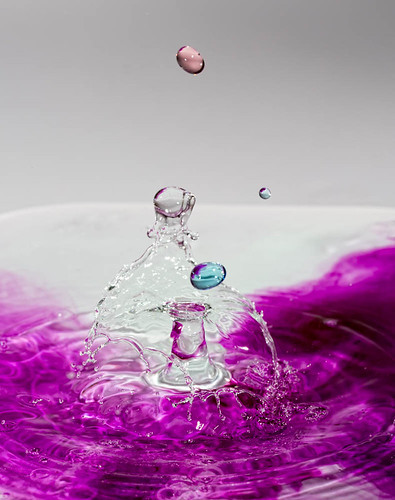Just thought I would post a bit about my water drop setup progression. These photos were all taken with two Stopshots from Cognisys.
This first shot is an example of what I could do before I rebuilt my setup. The orange is from food coloring while the background is construction paper. The shot is relatively simple. I use one drop to get the column then hit it with a second drop to create the splash.

Ending with a Splash by CalevPhoto, on Flickr
In this next shot I rebuilt the siphon system to support three configurable siphons. This allows me to use three different colored drops in a single photo. The rest of the system is similar with the same plate holding the water. I illuminated the background slightly, but otherwise didn't do anything there.

The Well of Souls by CalevPhoto, on Flickr
In the next shot I moved to illuminating from underneath. I used a Tupperware container and a glass dish. Although I could use three siphons, I only used one siphon here and the shot is similar in complexity to the first one. The difference in shape is due to the makeup of the liquid. There are a number of problems with this shot and I realized after taking it that the Tupperware was not very practical.

Watercolor by CalevPhoto, on Flickr
The last shot I took yesterday. I built a small light table and rested the glass dish on it. One flash was used to light from below while another was geled and placed behind the table to create the background. Another flash illuminated from the side. Two siphons were used.

Drop Playground by CalevPhoto, on Flickr
I am getting there, but more work needs to be done.
This first shot is an example of what I could do before I rebuilt my setup. The orange is from food coloring while the background is construction paper. The shot is relatively simple. I use one drop to get the column then hit it with a second drop to create the splash.

Ending with a Splash by CalevPhoto, on Flickr
In this next shot I rebuilt the siphon system to support three configurable siphons. This allows me to use three different colored drops in a single photo. The rest of the system is similar with the same plate holding the water. I illuminated the background slightly, but otherwise didn't do anything there.

The Well of Souls by CalevPhoto, on Flickr
In the next shot I moved to illuminating from underneath. I used a Tupperware container and a glass dish. Although I could use three siphons, I only used one siphon here and the shot is similar in complexity to the first one. The difference in shape is due to the makeup of the liquid. There are a number of problems with this shot and I realized after taking it that the Tupperware was not very practical.

Watercolor by CalevPhoto, on Flickr
The last shot I took yesterday. I built a small light table and rested the glass dish on it. One flash was used to light from below while another was geled and placed behind the table to create the background. Another flash illuminated from the side. Two siphons were used.

Drop Playground by CalevPhoto, on Flickr
I am getting there, but more work needs to be done.
- The table shook a bit and was not level. This is the reason for the unlevel background and harsh transition on the side. I have since fixed this with leveling legs.
- I need more flashes for the setup. In particular I would like at least two for the background, another one on the other side, and two for underneath (to light up the water behind the drop more).
- I bought polarized filter paper for my flashes and have a polarizer for my lens. I just need to brave up and cut it ($50/sheet) and use it on the side flashes to see the effect - which I hope removes some of the glare I spend time in PP removing
